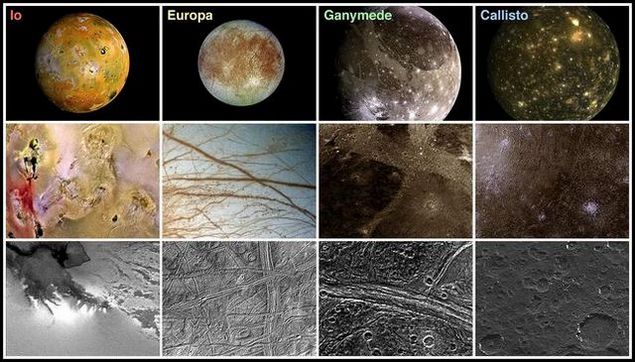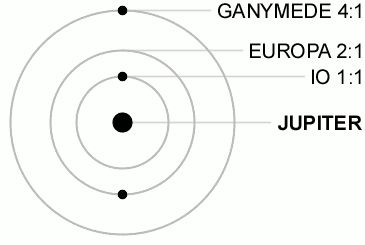The Galilean moons are the four largest moons of Jupiter Io, Europa, Ganymede, and Callisto. They were discovered by Galileo Galilei around January 1610 and were the first group of objects found to orbit another planet. Their names derive from the lovers of Zeus. They are among the most massive objects in the Solar System with the exception of the Sun and the eight planets, with radii larger than any of the dwarf planets. Ganymede is the largest moon in the Solar System, and is even bigger than the planet Mercury.

The three inner moons Io, Europa, and Ganymede are in a 4:2:1 orbital resonance with each other. Fluctuations in the orbits of the moons indicate that their mean density decreases with distance from Jupiter. Callisto, the outermost and least dense of the four, has a density intermediate between ice and rock whereas Io, the innermost and densest moon, has a density intermediate between rock and iron.

Callisto has an ancient, heavily-cratered and unaltered ice surface and the way it rotates indicates that its density is equally distributed, suggesting that it has no rocky or metallic core but consists of a homogeneous mix of rock and ice.
Fof more info please visit the wikipedia.org
Ganymede
Is the largest moon of Jupiter and in the Solar System, and the only moon known to have a magnetosphere. It is the seventh satellite outward from Jupiter and third of the Galilean moons, the first group of objects discovered orbiting another planet. Completing an orbit in roughly seven days, Ganymede participates in a 1:2:4 orbital resonance with the moons Europa and Io, respectively. With a diameter of 5,268 km (3,273 mi), it is 8% larger than the planet Mercury, but has only 45% as much mass. Its diameter is 2% larger than that of Saturn's Titan, the Solar System's second-largest moon. At 2.02 times the mass of the Moon, it is the most massive planetary satellite. It is the 9th largest object in the Solar System, and the largest without a substantial atmosphere.
Ganymede is composed of approximately equal amounts of silicate rock and water ice. It is a fully differentiated body with an iron-rich, liquid core, and an internal ocean that may contain more water than all of Earth's oceans together.Its surface is composed of two main types of terrain. Dark regions, saturated with impact craters and dated to four billion years ago, cover about a third of the satellite. Lighter regions, crosscut by extensive grooves and ridges and only slightly less ancient, cover the remainder. The cause of the light terrain's disrupted geology is not fully known, but was likely the result of tectonic activity brought about by tidal heating.

Ganymede's magnetosphere was probably created through convection within its liquid iron core. The meager magnetosphere is buried within Jupiter's much larger magnetic field and would show only as a local perturbation of the field lines. The satellite has a thin oxygen atmosphere that includes O, O2, and possibly O3 (ozone). Atomic hydrogen is a minor atmospheric constituent. Whether the satellite has an ionosphere associated with its atmosphere is unresolved.
Ganymede : detailed specification and data
SAFETY WARNINGS
Terrain specified in the header corresponds to the real situation in terrain of the cache placement. Please consider your options, capabilities weather conditions. Remember that the safety is in first place in all circumstances. All you are doing is on your own risk, the author assumes no responsibility. Please protect the nature.
BEZPEČNOSTNÍ UPOZORNĚNÍ
Terén uvedený v záhlaví odpovídá skutečnému uložení krabičky a proto prosím zvažte vaše možnosti, schopnosti, povětrnostní podmínky. Pamatujte že bezpečnost je až na prvním místě. Kešku lovíte na vlastní nebezpečí, autor nenese žádnou odpovědnost. K přírodě se chovejte ohleduplně a neničte ji.